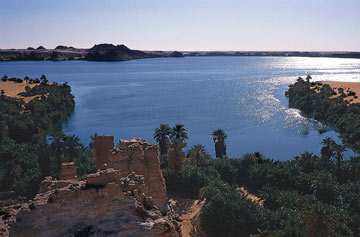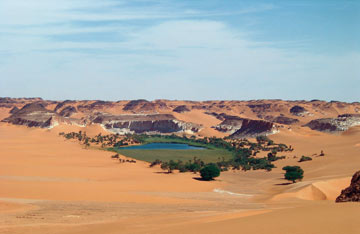|
NEWS NOTES
Un-greening the Sahara
 courtesy of S. Kröpelin/University of Cologne |
| Above and below: An oasis in the middle of the Sahara, Lake Yoa in northern Chad, contains another prize: the only known continuous sediment record in the Sahara over the past 6,000 years. |
 courtesy of S. Kröpelin/University of Cologne |
Once upon a time — about 10,500 years ago — North Africa was a green, grassy landscape, dotted with lakes, wetlands, tropical trees, herbs and shrubs. Then the summer monsoons began to bring less rain. Sometime between 6,000 and 2,700 years ago, that life-supporting savannah became the Sahara Desert.
Whether that transformation happened gradually, over several thousand years, or abruptly, in just a few hundred years, has been a matter of debate. But now, the first direct sediment evidence from the Sahara itself suggests an answer: The drying-out took thousands of years.
Assessing the climatic history of the Sahara over the past 10,000 years or so has been tricky, because a complete sediment record that contains direct evidence of climate conditions has been lacking. The loose sediments that covered the basins of ancient dried-up lakes that might have contained such evidence have long since been picked up by winds and blown away. But those winds also carried fine sediments from the desert westward into the equatorial Atlantic Ocean and deposited them on the seafloor. Thus, sediment cores from this region contain a record of the Sahara’s climate. And about eight years ago, scientists studying those cores discovered a sudden large increase in sandy deposits from Africa about 5,500 years ago, suggesting that the Sahara had abruptly dried.
But Stefan Kröpelin, a geoarchaeologist at the University of Cologne in Köln, Germany, was not convinced. Much of the terrestrial evidence that existed from the Sahara did not support a sudden change, he says. Archaeological evidence from the eastern Sahara suggests that people slowly made their way southward, he says, and the bones of wild and domestic animals, as well as evidence from plants, also suggested a slow southward migration.
Between remote locations, hot dry conditions and ongoing civil unrest and warfare, finding a direct sediment record of climate change on land in the Sahara has been challenging, he says. But in 1999, Kröpelin, who has investigated the Sahara’s climatic and archaeological past for more than 30 years, traveled to a desert oasis in northern Chad, where a lake called Yoa has persisted for thousands of years. Although once supplemented by rain and perhaps river runoff, the 26-meter-deep lake is now fed only by groundwater.
The lake’s undisturbed basin contains a complete, finely detailed record of pollen spores and dust deposits over the last several thousand years. From the bottom of the lake, Kröpelin and his team recovered a nine-meter-long core representing 6,000 years of sedimentation. Because the core was finely laminated, the team could distinguish individual years, and even seasons, within the record.
They found a record of a continuous slow evolution of pollen types, plankton and water chemistry in and around the lake, supporting the idea that the Sahara’s climate changed gradually, Kröpelin says. From 6,000 years ago to about 2,700 years ago, the lake core showed a succession of vegetation types that indicated a drying climate, from tropical trees to grassy savannah with hardier acacias to semi-desert plants, the researchers reported May 9 in Science. Fossil plankton in the lake sediments suggested that the lake itself became much saltier around 3,800 years ago, in contrast to the more gradual vegetation changes.
The new data do not necessarily conflict with what the marine record seems to be saying, however, says Peter deMenocal, a paleoceanographer at Columbia University’s Lamont-Doherty Earth Observatory in Palisades, N.Y., who found the original cores in the Atlantic. “The issue comes down to one of timing,” deMenocal says. “One thing that we’d both agree on is that all of Africa didn’t suddenly become dry at 5,500 years ago,” he says. “That’s what I see in my record, but I would not suggest that all of Africa synchronously became dry at that moment.” Instead, he says, it’s possible that the lake record simply represents a difference in timing of climate change across the region.
The two records could indeed simply be telling two different aspects of the same story, says Jonathan Holmes, a geographer at University College London in the United Kingdom. “I don’t believe either is wrong,” Holmes says. Instead, he says, what may explain the discrepancy is that dust records from the Sahara may be integrating events across a large geographical area, giving a broad-brush picture. The Lake Yoa record, meanwhile, could be a much more localized scale, he says.
To some extent, understanding what happened in the Sahara might provide clues for future changes — and understanding how the climate and vegetation in the region interact can help modelers develop a more accurate picture of these interactions. Still, Holmes says, “we can’t use the past as a direct model for what will happen in the future.” For one thing, not everyone agrees that the Sahara might re-green in the future as a result of climate change. Some scientists suggest that the whole of North Africa could undergo further drying. But “any records telling about the past in North Africa are interesting,” he adds. “They give an indication about how things evolve, about how the region operates as a vegetation-climate system.”

 Subscribe
Subscribe


